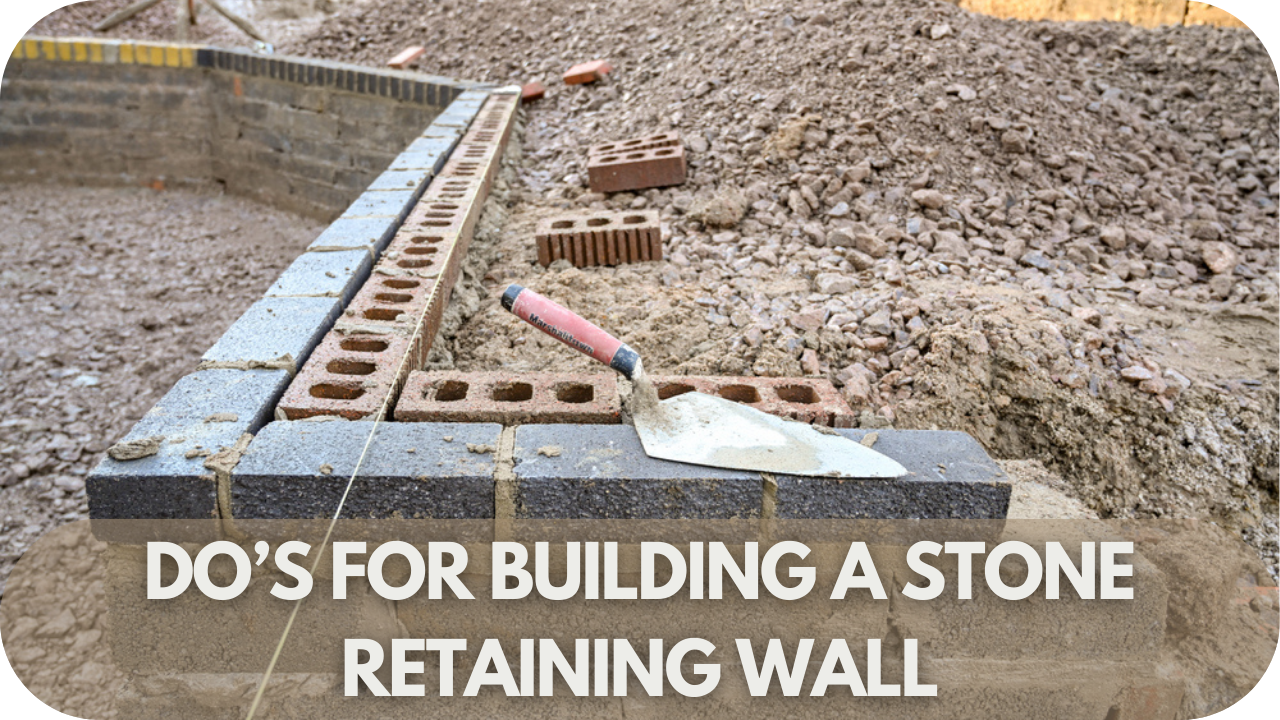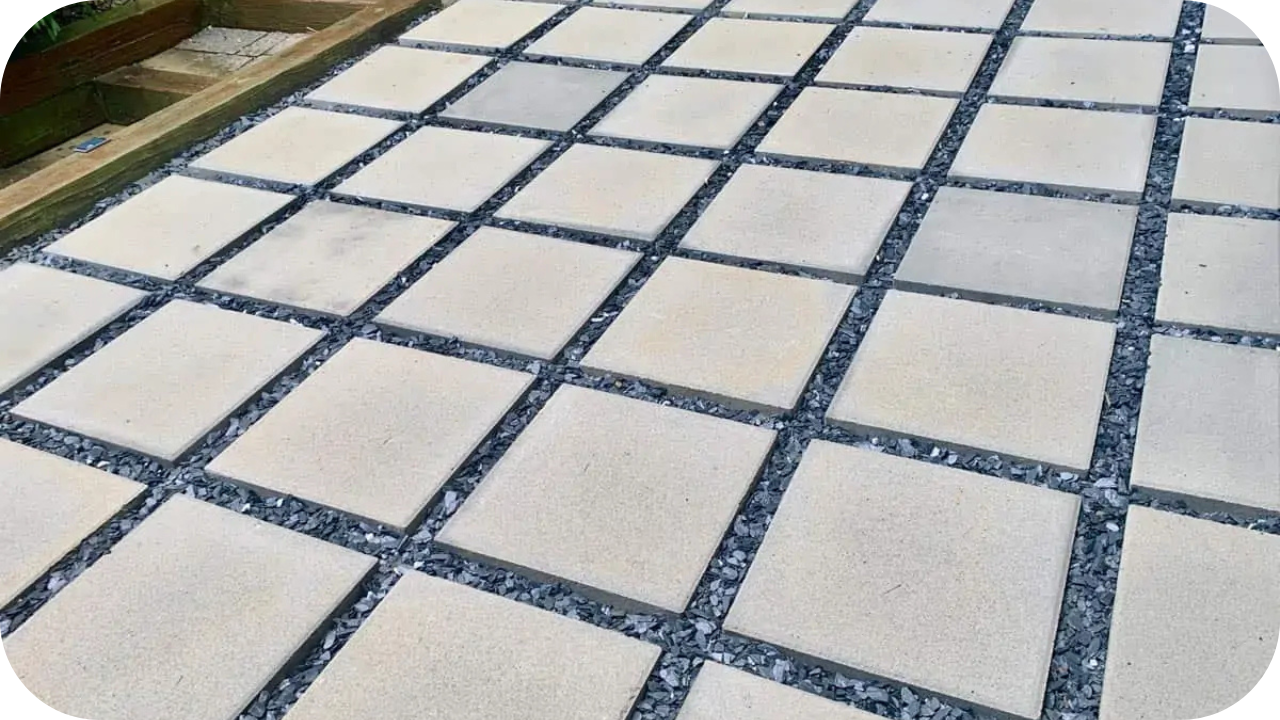
Building a stone retaining wall can be the perfect DIY project to enhance your garden’s aesthetic and functionality.
However, a few missteps could turn your dream wall into a costly nightmare. From choosing the right materials to ensuring proper drainage, every decision counts. Whether you’re a seasoned DIY enthusiast or a first-timer, getting the dos and don’ts right is crucial.
Stick with us to uncover expert tips for making your stone retaining wall sturdy and a stunning feature in your outdoor space.
Do’s for Building a Stone Retaining Wall

A stone retaining enhances both functionality and aesthetics; follow these essential steps to ensure your project is structurally sound and visually stunning, creating a lasting feature in your garden.
1. Plan Your Project Thoroughly
A solid plan is crucial to a successful stone retaining wall. Take the time to carefully consider factors like location, wall height, materials, and the intended function of the wall. Don’t forget to check local building codes and zoning regulations to avoid any compliance issues during construction.
2. Choose the Right Stone for the Job
Select durable stones such as granite, limestone, sandstone, or fieldstone, which are well-known for their strength and aesthetic value. The right stone will complement your garden’s look while ensuring the wall’s structural integrity. Matching the stone to your landscape’s style is an excellent idea for a cohesive outdoor design.
3. Dig a Proper Foundation Trench
Digging a trench at least 6-12 inches deep is essential for stability and durability. A properly dug foundation will prevent the wall from shifting over time. Use gravel or crushed stone to enhance drainage behind the wall, and ensure the trench is level for a straight and even structure.
4. Use Proper Drainage Techniques

Effective drainage is essential to avoid water buildup behind the wall, which could lead to shifting or collapse. Install weep holes, perforated pipes, and drainage fabric to promote water flow and reduce hydrostatic pressure. Incorporating gravel behind the wall helps maintain its structural integrity and longevity.
5. Stack Stones Correctly
Start with the largest stones at the base, working upwards and tapering the layers. Each stone should be level and securely interlocked to prevent shifting. Gently tap each stone into place with a rubber mallet to ensure a snug fit without cracking or damaging the stones.
6. Secure Stones with Mortar or Adhesive
Consider using mortar or stone adhesive to hold the stones in place for taller retaining walls under significant pressure. While dry-stacking can be effective, using mortar or adhesive adds extra security and can be especially important for added strength in high-stress areas.
7. Consider Reinforcement for Taller Walls
Reinforcement is often necessary for walls exceeding 3 feet in height to prevent instability or shifting. Reinforcements such as geogrids, rebar, or metal ties can distribute the wall’s weight and provide additional structural support, ensuring your wall stays solid and secure.
8. Maintain and Inspect Regularly
Once the retaining wall is built, it’s essential to perform regular maintenance checks. Look for signs of settling, cracking, or shifting. Periodic inspections and minor repairs can help prevent bigger issues down the line, ensuring your stone wall remains strong, functional, and visually appealing for years.
Don’ts for Building a Stone Retaining Wall

Building a stone retaining wall can transform your garden, but avoiding common mistakes is crucial. Follow these essential don’ts to ensure your DIY project is sturdy, long-lasting, and safe.
1. Skip the Site Preparation
Proper site preparation is essential for stability. Remove weeds and debris, and ensure the ground is level to avoid uneven walls or drainage problems. Skipping this step can lead to shifting, cracking, or water-related damage, compromising the wall’s integrity.
2. Use Stones That Are Too Small or Weak
Avoid using small or fragile stones that can’t bear the pressure. Stones like granite or sandstone are sturdy and load-bearing, ensuring your wall stays intact. Weak stones will break down under pressure, causing the wall to fail prematurely.
3. Build Too High Without Support
Walls over 3 feet need reinforcement for stability. Taller walls are prone to tipping or collapsing without proper support, such as geogrids or rebar. Always ensure that higher walls have the necessary structural support to withstand the weight and pressure.
4. Overlook Drainage Needs
Ignoring drainage can cause water buildup behind the wall, leading to erosion or collapse. Install proper drainage solutions like French drains, weep holes, and gravel to ensure water flows freely and prevent hydrostatic pressure from weakening the structure over time.
5. Stack Stones Too Tightly

Stacking stones too tightly can block proper drainage and cause instability. Leave space between stones to allow water to flow through and prevent pressure from building up. This also allows the wall to settle naturally without compromising its strength.
6. Forget to Account for Wall Settlement
Retaining walls naturally settle over time. Failure to account for this can cause cracks and gaps. Leave some slack when placing stones, and avoid over-compacting the base. This ensures the wall can adjust without becoming unstable or requiring costly repairs.
7. Rush the Project
Rushing the construction process can lead to misaligned stones, uneven layers, or skipped steps. Take your time to level each stone carefully and ensure proper alignment. Patience ensures a strong, well-built wall that will stand the test of time.
When to Call a Professional

While building a stone retaining wall can be a rewarding DIY project, some situations require professional expertise to ensure safety, stability, and durability. Here’s when you should call in the experts:
- Walls Over 1 Metre in Height: Taller walls require structural reinforcement to prevent collapse. Professionals ensure proper engineering for safety and durability.
- Complex Designs: Curved, tiered, or intricate designs demand precision and expertise. A professional ensures both structural stability and visual appeal.
- Unstable Soil Conditions: Loose, sandy, or clay-heavy soil complicates foundation preparation. Experts use specialised methods to stabilise and secure the wall.
- Persistent Drainage Issues: Poor drainage can cause erosion or wall failure. Professionals implement advanced systems to manage water effectively.
- Safety and Longevity Concerns: Uncertainty about the wall’s integrity warrants professional input. They guarantee a safe, long-lasting structure that meets your needs.
Maintenance and Care for Your Stone Retaining Wall

To keep your stone retaining wall in top shape and ensure its longevity, follow these essential maintenance tips:
- Inspect Regularly: Check for shifting stones, cracks, or erosion at least once a year. Early detection can prevent structural damage and ensure the wall’s long-term stability. Regular inspections are vital.
- Clear Drainage Systems: Ensure weep holes, drainage pipes, and gravel are debris-free. Blocked drainage can cause water to accumulate behind the wall, leading to erosion and eventual collapse. Keep it clear.
- Clean Periodically: Wash away dirt, moss, and algae using a mild detergent and warm water. Avoid harsh chemicals that could damage the surface or leave stains. Regular cleaning preserves the wall’s appearance.
- Seal the Stone: Apply a high-quality sealant to protect your stone from moisture and stains. Sealing enhances the wall’s durability and beauty, preventing weathering over time.
- Address Settling: Walls naturally settle over time. Refill gaps and relevel stones to prevent unevenness or cracks. Regular maintenance will ensure the wall stays stable and secure in the long run.
- Check for Vegetation Growth: Plants, moss, or weeds growing through gaps can damage the wall and affect its stability. Remove any unwanted growth to maintain the integrity of your stone structure.
Conclusion
Building a stone retaining wall is a rewarding DIY project, but success lies in the details. By following the do’s and avoiding the don’ts, you can create a sturdy and visually appealing feature that enhances your landscape.
Regular maintenance will ensure its longevity and performance. Ready to get started? Visit Splendour in Stone for premium materials and expert advice to help bring your retaining wall vision to life. Your dream garden begins with the proper foundation!
More To Explore

Top Outdoor Paving Ideas for Aussie Backyards
Are you ready to transform your Aussie backyard with stunning paving ideas? Whether you’re looking to create a stylish outdoor entertaining area, a functional pathway,

Small Backyard? Here’s How to Maximise with Stone
Struggling to make the most of your small backyard space? Many homeowners with limited outdoor areas feel restricted when it comes to design. But what


